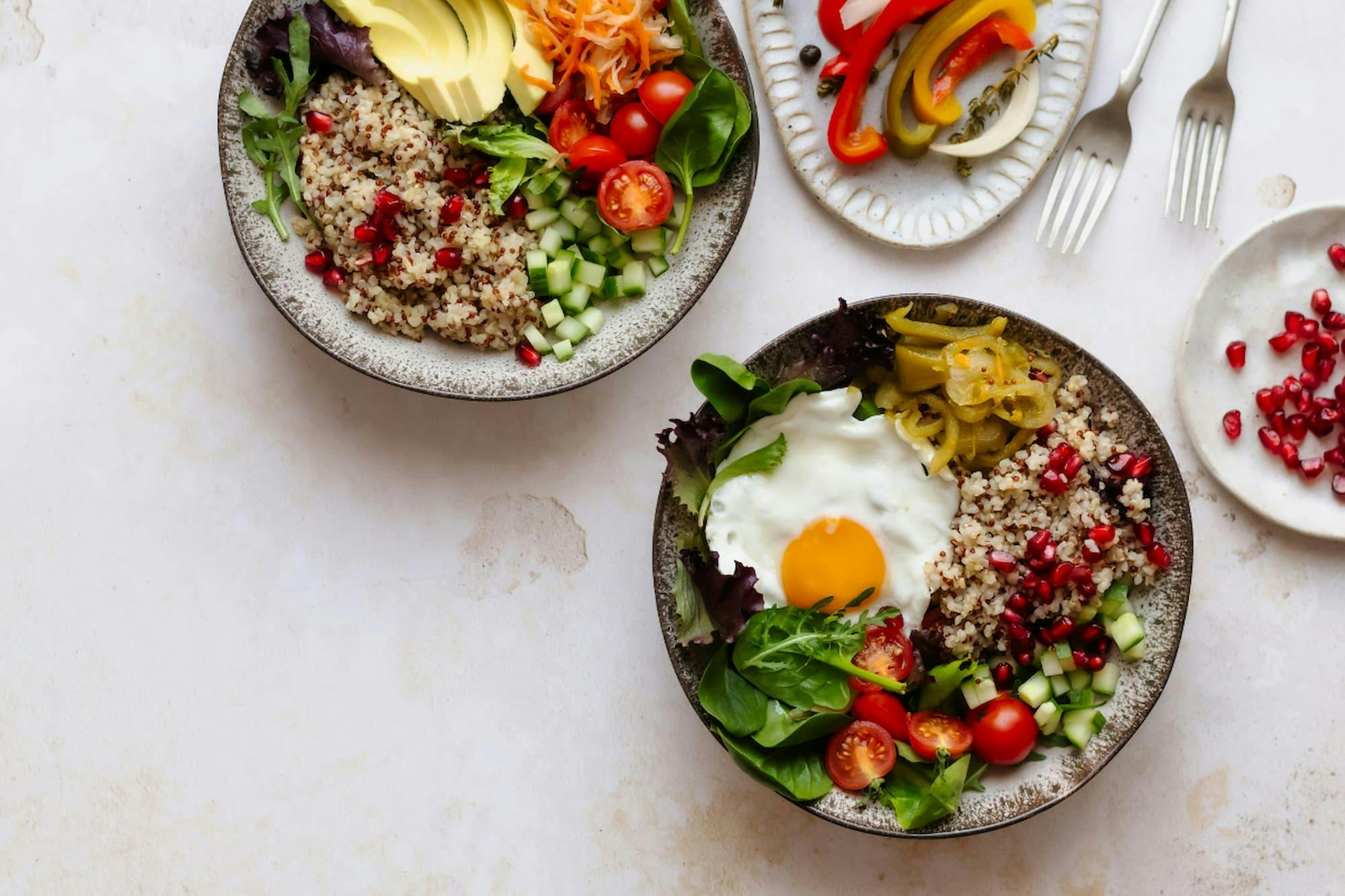Lunch should bring people together—not leave them out. This guide shows how to provide vegan and vegetarian lunch options in the office that are easy, inclusive, and genuinely appreciated.
We’ve all seen it happen—team lunch is served, the vibe is good, people are laughing and loading their plates. Except for the few quietly scanning the table, realizing there’s nothing there for them.
Maybe they don’t eat meat. Maybe they avoid dairy.
Either way, they’re left out while everyone else enjoys the meal.
It seems small, but moments like that stick. When someone’s dietary needs are overlooked, it can make them feel excluded—like they weren’t part of the plan.
The good news? Fixing it is easier than you think.
Offering vegan and vegetarian lunch options in the office is a practical way to support your team’s health, meet dietary needs, and build a more inclusive workplace culture. And it’s not about overhauling everything—it’s about broadening what you offer so more people feel seen, included, and well-fed.
Let’s break down why and how to provide meals that make everyone feel part of the table.
Why Vegan and Vegetarian Options Matter in the Workplace
Eating together is more than just fueling up. Eating is a communal act that helps people connect, relax, and feel part of something bigger. That’s why what you serve at work lunches matters.
When team meals are planned with intention, you deliver a strong message. Including plant-based options shows that you’re thinking about the real people behind the job titles, and that kind of inclusivity goes a long way in building trust, loyalty, and a stronger workplace culture.
That starts with understanding what these options actually mean. Vegetarian meals typically exclude meat, poultry, and seafood but may include dairy or eggs. Vegan meals go further, avoiding all animal products—including meat, dairy, eggs, and honey—in favor of ingredients like vegetables, grains, legumes, nuts, seeds, and plant-based proteins.
With those guidelines in mind, it’s easier to offer meals that meet a range of dietary needs—without leaving anyone out.
Bring the perfect lunch solution to your office.
Picnic will deliver lunch from 50+ restaurants without fees or tips, directly to your office — available in all major US cities


Read more: What Is Office Meal Planning, and How Can You Simplify It?
Employee Wellbeing and Inclusivity
Offering vegetarian and vegan lunch choices is a meaningful gesture of consideration. It signals that the workplace is inclusive of diverse needs—whether those are based on lifestyle, health, or culture.
Well-planned plant-based diets are linked to better energy levels, reduced risk of chronic illness, and improved overall wellbeing. And when those options are available at work, employees don’t have to compromise their health or values to fit in.
Beyond those who identify as vegan or vegetarian, meat-free meals can also be a safe option for employees with food allergies or intolerances—like lactose intolerance or egg allergies. And because vegan meals are free from common animal products, they’re often suitable (or easily adaptable) for people who follow religious dietary laws such as halal or kosher.
Responding to Dietary Trends and Sustainability
Interest in whole food, plant-focused lunch options isn’t a fringe trend—it’s a growing movement. More people are reducing meat and dairy for health reasons, environmental concerns, or personal values.
Workplaces that reflect this shift show they’re paying attention—not just to the bottom line, but to what matters to their people.
Plant-based diets are associated with both improved health outcomes and lower environmental impact. Supporting those choices in the office isn’t just good for employees—it’s a step toward a more sustainable and forward-thinking workplace.
The Business Benefits of Plant-Based Options
Incorporating animal-free meals into your workplace dining strategy offers tangible advantages beyond catering to dietary preferences. Here are a few of them:
- Boosts Morale, Satisfaction, and Retention: Providing diverse and inclusive meal options can significantly impact employee satisfaction and retention. Especially when those meals reflect a variety of dietary needs.
- Positions Company as Modern and Inclusive: Offering plant-based lunch options signals a commitment to building a workplace that values diversity and modern lifestyle choices.
- Supports Sustainability Goals: Meat-free meals aren’t just good for people—they’re better for the planet too. Reducing animal products in your food program can significantly lower your company’s carbon footprint and help meet environmental and ESG commitments.
Of course, even with all these benefits, offering inclusive office catering isn’t without its challenges. Let’s take a look at the most common ones—and how to solve them.

Common Challenges When Providing Vegan and Vegetarian Meals
Providing vegetarian and vegan lunch options at work should be simple—after all, most of the world’s food is already plant-based. But in practice, that’s not always the case.
Many office menus fall short, either by offering uninspired options or by misunderstanding what a balanced vegetarian meal really looks like.
Let’s look at a few common challenges that come up—and how to overcome them.
Lack of Variety and Creativity
One of the biggest complaints about vegetarian catering for offices is the lack of variety. Too often, the only meat-free option is a plain salad or a side of fries (that’s if the fries weren’t cooked in animal fat). It sends the message that these meals were an afterthought.
Serving vegan meals is a lot easier than it seems. Dishes like roasted veggie grain bowls, spicy lentil stews, tofu stir-fries, chickpea curries, hearty plant-based pastas, and wraps with hummus, grilled vegetables, or marinated tempeh are all satisfying, balanced, and easy to prepare or cater. These meals don’t just “get by”—they impress, nourish, and include everyone at the table.
A little creativity goes a long way in making everyone feel included and excited about mealtime.
Dietary Misconceptions and Stereotypes
Another wrong assumption is that plant-based meals are somehow lacking—either in flavor or nutrition. There’s a lingering stereotype that these meals are bland, unsatisfying, or not “real” food.
But this couldn’t be further from the truth. A well-planned vegetarian and vegan lunch can be rich in protein, fiber, healthy fats, and flavor. It’s also good to remember that most flavor-building ingredients—garlic, onions, herbs, pepper, and spices—are naturally vegan. These are the backbone of most great dishes, plant-based or not.
Busting these myths internally can help shift attitudes and open people up to trying something new—especially when the food itself speaks for its quality.
Catering for Mixed Dietary Needs in the Same Meal
It can be challenging to design a menu that satisfies everyone—vegans, vegetarians, meat-eaters, and people with food allergies or religious dietary restrictions. But one of the strengths of plant-based lunch options is their adaptability.
Vegetarian meals can often be more inclusive by default: they’re free from pork, shellfish, or other ingredients restricted in halal or kosher diets, and can be more easily adapted for allergies (like dairy or eggs). A vegan curry, for example, can be suitable for many dietary needs without requiring multiple versions of the same dish.
Still, not everyone will be thrilled by the idea of going plant-based. Some may resist the change or dismiss it as a trend. That’s okay. Be patient. Start small. Introduce options gradually, offer education around the health benefits, and encourage open-mindedness.
Over time, thoughtful, inclusive meals can help shift perspectives—and create a more connected, respectful office culture.

How to Provide Vegan and Vegetarian Lunch Options in the Office
If you want to create a more inclusive culture, providing inclusive lunch options is the first step. With a little planning and the right partners, offering plant-based meals can become a seamless part of your workplace routine.
Here’s how to make it work—without sacrificing variety, taste, or convenience.
Partner with Flexible Catering Services like Picnic
The most effective way to support diverse dietary needs is to work with a catering partner that already knows how to do it.
With a platform like Picnic, everyone gets what they want—without creating extra work for you. The vegan can choose a hearty grain bowl, the gluten-free team member can get something safe and satisfying, and the guy who just wants a bacon cheeseburger? He’s covered too.
Employees can easily select vegan or vegetarian meals themselves during the ordering process—no awkward requests or extra steps needed. Picnic’s system allows people to indicate dietary preferences upfront, so no one has to feel like they’re asking for a special favor.
Picnic handles mixed dietary preferences, letting employees order individually while keeping everything streamlined on your end.
Offer Diverse Menu Choices Regularly
It’s not enough to have one vegan wrap on the menu. To make your plant-based offerings meaningful—and to keep people interested—you need to rotate and diversify the menu.
Offering a wide range of vegetarian and vegan lunch options supports nutritional balance and shows your team that these meals aren’t an afterthought. Think globally inspired dishes, seasonal vegetables, creative meat alternatives, and protein-rich ingredients like legumes, tofu, tempeh, or grains.
Include Plant-Based Options in Company Events and Meetings
Plant-based meals shouldn’t be limited to regular lunch days—they should be part of your full food strategy. From catered meetings and training sessions to company celebrations and retreats, make sure vegan and vegetarian lunch options are clearly available and just as appealing as the rest of the menu.
When you normalize inclusive food choices across all workplace events, you remove the stigma and send the message that everyone deserves to feel welcome—no matter what’s on their plate.

Tips to Create a Vegan-Friendly Office Culture
Offering vegetarian and vegan lunch options is a great start—but creating a truly vegan-friendly workplace goes beyond what’s on the plate. It’s about building an environment where all food choices are respected and where inclusivity shows up in everyday moments, not just on themed days.
Here’s how to bring that culture to life.
Lead by Example: Encourage Managers to Participate
Culture change sticks when it starts at the top. When managers and leaders support and engage with inclusive office catering—whether by trying plant-based meals themselves or simply being supportive—it helps normalize it across the team.
Their participation signals that diverse food choices are part of how the company works, not a side note.
Organize Plant-Based Lunch Days or Challenges
Introducing fun, low-pressure initiatives like Meatless Mondays or plant-based lunch challenges gives your team a reason to try something new together.
These kinds of shared experiences don’t just expose people to new flavors—they also strengthen team connection.
Educate Teams on Plant-Based Nutrition
Many people are curious about plant-based eating but unsure where to start. Providing clear, non-preachy information—like nutritional benefits, easy meal swaps, or common myths—can help demystify it.
It’s also helpful to normalize asking for plant-based options. Let employees know it’s okay to request vegan meals when ordering, attending events, or filling out catering forms. If you’re using a food platform or working with a caterer, offer a place for people to specify their dietary needs—this small step makes a big difference in feeling seen and supported.
Whether it’s through casual messages, printed tips in the kitchen, or a guest nutritionist, education builds comfort and confidence around vegan and vegetarian food choices.
Promote Inclusive Communication Around Food Choices
The way we talk about food matters. Framing plant-based options as “just for some people” or treating them like a novelty can alienate team members. Inclusive language helps everyone feel welcome at the table.
Clear, respectful labeling is a great start—use terms like “vegan,” “vegetarian,” or “contains dairy” directly on menus and catering orders. Avoid vague terms like “healthy” or “alternative” and be transparent about ingredients so employees can make informed choices without needing to ask.
Being intentional in how you word menus, invitations, or lunch announcements can go a long way—especially when planning around dietary needs.
Bring Inclusive Office Dining to the Table
Creating a workplace where everyone feels seen—even at the lunch table—starts with the food you serve. Offering thoughtful corporate lunch ideas isn’t just about keeping up with trends. It’s about building a culture of care, inclusion, and wellbeing.
With a flexible catering partner like Picnic, it’s easy to provide meals that reflect the diversity of your team—whether they’re plant-based, gluten-free, or just craving their favorite comfort food.
Ready to bring more inclusive meals to your workplace? Try Picnic Today!








